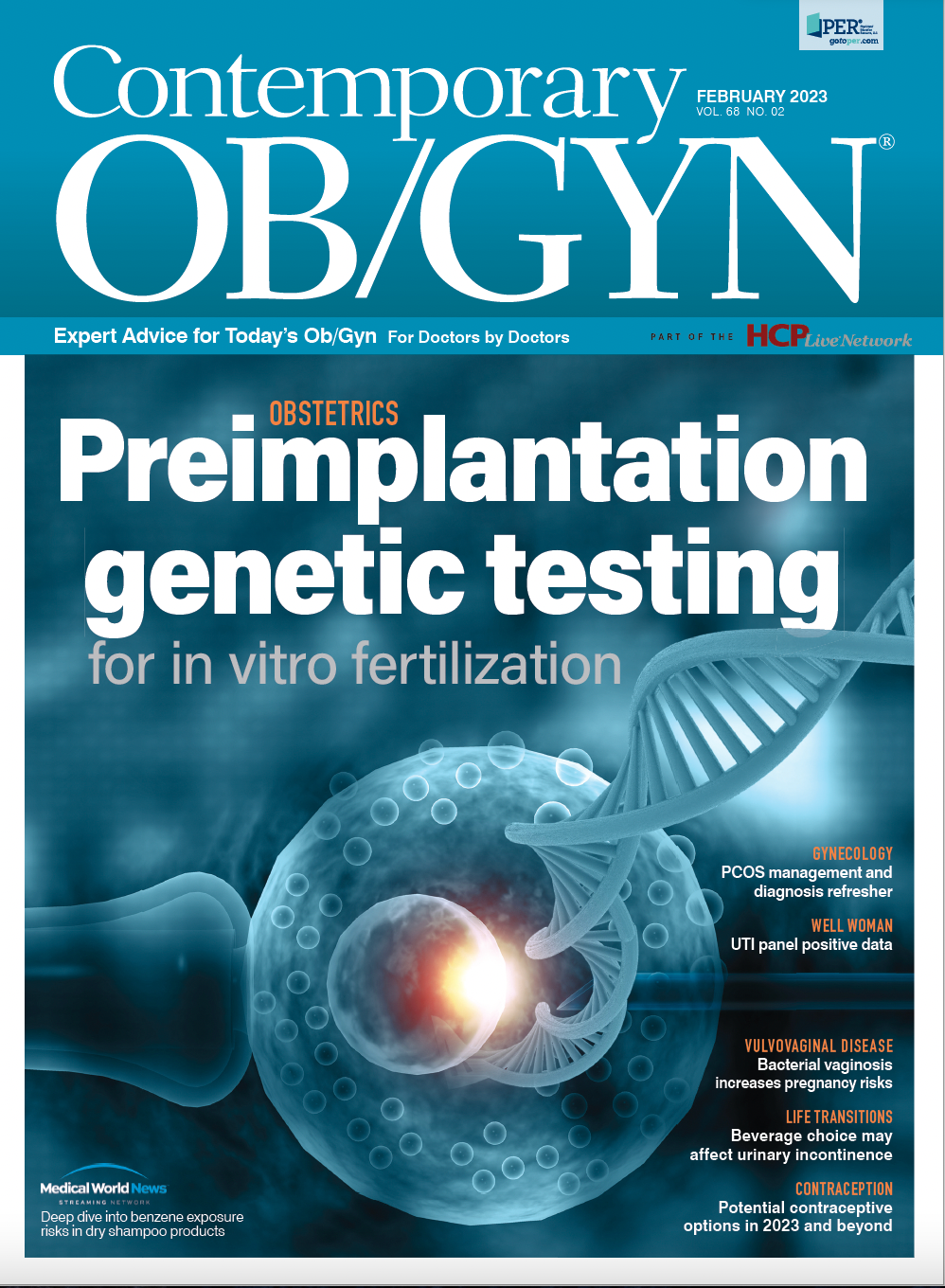Getting a grip on polycystic ovary syndrome
A diagnosis and management refresher.
Polycystic ovary syndrome (PCOS) is an endocrine and metabolic condition that affects up to 20% of premenopausal women.1 It is multifactorial, with its etiology largely unknown. The syndrome is characterized by a triad of hyperandrogenism, ovulatory dysfunction, and polycystic ovarian morphology (PCOM).
Hyperandrogenism can manifest clinically as physical symptoms, such as hirsutism (male-pattern hair growth), acne, or alopecia.1 A clinical measure of hirsutism is the modified Ferriman-Gallwey score (Figure 1)2,3. Most recent guidelines classify a modified Ferriman-Gallwey score of 4 or greater as hirsute.3 Biochemical hyperandrogenism can be identified with elevated levels of serum-free or total testosterone or dehydroepiandrosterone sulfate.1
FIGURE 1. Examples of the Modified Ferriman-Gallwey Scoring
System for Hirsutism2,3

Ovulatory dysfunction often presents as amenorrhea, irregular (missed or delayed) menstrual cycles, or infertility.1,4,5 In a woman or adolescent more than 3 years from menarche, irregular menstrual cycles are defined as cycles lasting less than 21 days or greater than 35 days, less than 8 total cycles per year, or greater than 90 days for any 1 cycle.1
PCOM is defined as the presence of greater than or equal to 20 antral follicles per ovary (previously 12) or a volume greater than or equal to 10 mL per ovary, according to the most recent international guidelines (Figure 2).1,3,5
FIGURE 2. Transvaginal Ultrasound Images of Ovaries in a Nulligravida, Aged 30 Years1,3,5
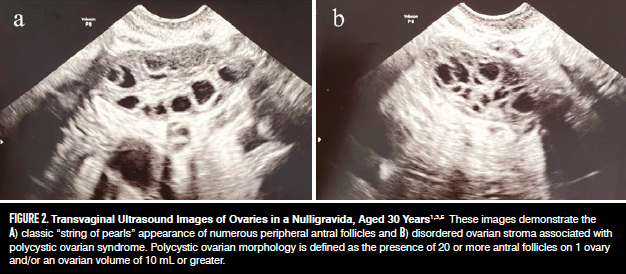
Women with PCOS are also at risk for long-term health sequelae, including infertility, insulin resistance, obesity, cardiovascular disease, metabolic syndrome, obstructive sleep apnea, and mood disorders. It is crucial to understand the diagnostic criteria to differentiate PCOS from other similarly presenting diagnoses. Management of PCOS varies depending on the phase of a woman’s reproductive life and includes a combination of lifestyle modifications and pharmacologic treatments targeted to specific symptoms.
Diagnosis
There is no universally accepted definition of PCOS. A well-known classification is the 2003 Rotterdam criteria, which expanded upon the 1990 National Institutes of Health (NIH) definition. The Rotterdam definition states that 2 of the following 3 criteria must be met to have the syndrome: hyperandrogenism (either clinical or biochemical), ovulatory dysfunction, or PCOM.6 As mentioned, this broadened the 1990 NIH criteria, which defined PCOS as the presence of ovulatory dysfunction with hyperandrogenism and did not incorporate ultrasonographic findings into the criteria.7
The 2006 Androgen Excess Society criteria require hyperandrogenism in conjunction with either ovulatory dysfunction or PCOM to make the diagnosis of PCOS.8 The 2012 NIH consensus statement further classifies 4 phenotypes of PCOS based on the criteria used to establish the diagnosis.9 These include phenotype A (hyperandrogenism, ovulatory dysfunction, and PCOM), phenotype B (hyperandrogenism and ovulatory dysfunction), phenotype C (hyperandrogenism and PCOM), and phenotype D (ovulatory dysfunction and PCOM) (Table).9,10
TABLE 1. A Summary of PCOS Diagnostic Criteria and Phenotypes9,10
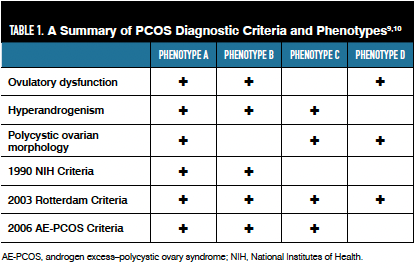
The most recent 2018 international guidelines endorse the use of the Rotterdam criteria for establishing a diagnosis of PCOS in adults.3
Each of the diagnostic criteria emphasizes the need to rule out additional alternative diagnoses. Before anchoring on a diagnosis of PCOS, other causes of menstrual irregularities or hyperandrogenism must be taken into consideration. For example, nonclassic congenital adrenal hyperplasia due to 21-hydroxylase deficiency can also lead to hirsutism, menstrual abnormalities, hyperandrogenism, and polycystic ovaries.1,5,11 Thyroid abnormalities or elevated levels of serum prolactin can cause irregular menstrual cycles.12 Androgen-secreting adrenal tumors can cause hirsutism and/or hyperandrogenism.1,5,13 Compared with PCOS, these neoplasms present with more extreme elevations in serum androgens or a more acute onset of hirsutism symptoms.13 Figure 3 summarizes the diagnostic work-up to rule out similarly presenting conditions.
FIGURE 3. An Overview of Diagnostic Laboratory Testing Involved in Establishing or Excluding a Diagnosis of PCOS
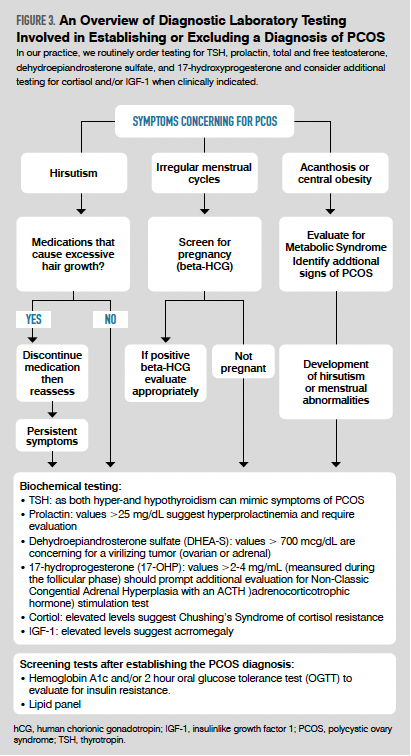
Pathogenesis of PCOS
The pathogenesis of PCOS is multifactorial and an active area of ongoing research. A genetic basis for PCOS was initially suggested by twin studies.14 More recently, genome-wide association studies have identified 19 specific loci associated with PCOS, the majority of which are shared among women of different races.15 However, these 19 genetic loci account for less than 10% of PCOS hereditability, suggesting the role of environmental factors.15 The impact of the environment on PCOS in a genetically predisposed individual may begin as early as in utero and continues throughout an individual’s lifetime, with environmental influences including geography, nutrition, socioeconomic status, and toxin exposures.16
Although there is not one specific “PCOS diet” for patients, research has shown that starch, whey, and dairy products have negative effects on metabolic function in women with PCOS and that fruits and beans (foods rich in inositol) have a positive effect.16 In addition, women with PCOS and a vitamin D deficiency are at increased risk of dysglycemia.17
The impact of socioeconomic status on PCOS was examined in one 2011 study, which found that women with a high education level whose parents had a low education level (defined as less than high school) were at the highest risk of developing PCOS, after adjustment for age, body mass index (BMI), and race (adjusted odds ratio, 2.5; 95% CI, 1.4-4.4).18
There is also a negative association between endocrine-disrupting chemicals and PCOS. One such example is bisphenol A (BPA), a compound found in consumer plastic products that can precipitate a negative feedback loop. An elevated serum BPA level can lead to elevated androgen levels, which then impair the metabolism of BPA, further increasing circulating
serum androgens.19,20
PCOS phenotypes differ in women of various races and ethnicities in the United States and internationally. For example, hirsutism is more prevalent and/or severe in Middle Eastern, Mediterranean, Indian, and South Asian women than in East Asian or US White women.21-25 Based on these findings, some have suggested specific racial and ethnic definitions of hirsutism.23,25,26 The racial/ethnic differences in hirsutism may be related to environmental factors as discussed below or genetic factors, such as the inheritance or expression of 5α reductase, an enzyme that converts testosterone to dihydrotestosterone, a more potent androgen.21,23,27
Metabolic consequences of PCOS and screening guidelines
Persons with PCOS are also at risk of potential detrimental long-term health sequelae. Insulin resistance (IR) is one of the most notable risks associated with PCOS, with a recent meta-analysis finding an odds ratio of 3.26 (95% CI 2.17-4.90) compared with the general population.28 In women with PCOS, IR has been associated with a higher prevalence of earlier-onset glucose intolerance (30%-40%) and type 2 diabetes (10%), and this risk is independent of, yet exacerbated by, the presence of obesity.29 Patients with PCOS should have IR screening at time of PCOS diagnosis and every 1 to 3 years thereafter.3,5,29 An oral glucose tolerance test (OGTT), fasting plasma glucose, or hemoglobin A1C can be used to assess glycemic status, but an OGTT is recommended in high-risk women (ie, BMI > 25 kg/m2 or > 23 kg/m2 in Asian women).3 In patients who desire pregnancy, the 75-g OGTT should be offered preconception, and if a woman is already pregnant, the test should be completed before 20 weeks’ gestation due to the elevated risk of gestational diabetes.3
Obesity is highly associated with PCOS and intensifies features of PCOS, such as infertility and IR. Obesity alone is a risk factor for the development of obstructive sleep apnea (OSA), but recent research recognizes an association between obesity and PCOS. OSA rates have been found to be 5- to 10-fold higher in patients who are obese and have PCOS.30 OSA increases the risk of a woman with PCOS developing cardiovascular disease (CVD).30
Dyslipidemia is another key adverse effect of PCOS, with prevalence of up to 70%.31 The Androgen Excess Society recommends that all patients with PCOS get a complete fasting lipid panel as a screening tool.32,33 PCOS, in women with obesity and without, is associated with elevated levels of total cholesterol and low-density lipoprotein, placing patients at risk for metabolic syndrome as well as CVD.32-35
The association between PCOS and CVD is inconclusive, but research has shown a correlation between exposure over time to worsening disease in this population.36,37 It has been demonstrated that increased coronary artery and aortic calcification exists in patients with PCOS that worsens with age,37 leading to premature atherosclerosis or subclinical vascular disease.38,39 Recommended screening guidelines for CVD in women with PCOS include a measurement of weight and BMI every 6 to 12 months and a measurement of blood pressure at least once per year.3 Women with PCOS should be considered at risk of CVD if they have any additional risk factors (obesity, use of tobacco, dyslipidemia, hypertension, impaired glucose tolerance, or lack of physical activity).3
Endometrial hyperplasia is another sequela of PCOS and a risk factor for the development of endometrial carcinoma. This is in large part due to unsuppressed estrogen exposure related to anovulatory states in PCOS.40 Women with PCOS are at least 3 times more likely to develop endometrial cancer vs women without PCOS.41-43 Routine screening for endometrial cancer is not recommended; however, providers should have a low threshold for evaluation of amenorrhea or abnormal vaginal bleeding in women with PCOS and consider ultrasound or endometrial biopsy.3 There are no official recommendations for the optimal prevention of endometrial hyperplasia; however, the 2018 international guidelines suggest treatment with combined oral contraceptive pills or progesterone if cycles last more than 90 days.3
PCOS also is associated with mental health disorders that often go underrepresented. Approximately 40% of women with PCOS, particularly younger ones, experience depression.44 Due to the high prevalence, all women with PCOS should be screened for anxiety and depression at the time of diagnosis and routinely thereafter.3 Often these symptoms arise from a variety of factors but commonly from experiencing obesity, hirsutism, or other changes in physical appearance. Clinicians also should be aware of the increased prevalence of eating disorders in women with PCOS, and if suspected, patients should be screened and appropriately referred to specialists.3
Management
Lifestyle modifications
To lower the risk of metabolic consequences, patients with PCOS should be counseled on lifestyle modifications, including nutrition, exercise, and behavioral strategies. The general recommendation is for healthy, well-balanced meals. In women with PCOS who are seeking weight loss, reducing caloric intake by up to 30% (500-700 cal/d) may be effective.3 Patients should also be counseled on the importance of consistent medium- or high-intensity exercise (at least 75-150 min/wk), including strength training,3 and reducing sedentary activities. Behavioral strategies of goal setting and self-monitoring can be useful in weight management and overall well-being in women with PCOS. In women with PCOS who are overweight or obese, even a 5% to 10% weight loss significantly improves metabolic and fertility outcomes.3
Pharmacologic treatments
Several pharmacologic treatments target specific symptoms of PCOS, particularly irregular menstrual cycles and hyperandrogen symptoms. Combined hormonal contraceptives (CHCs; pills, vaginal rings, and patches) are considered first-line.3 There is not any specific formulation or dose of estrogen or progesterone in CHC that is preferred, so practitioners should follow the standard guidelines for contraindications to CHC. Anovulatory or oligo-ovulatory women who are not candidates for CHC should be offered other forms of progestins to prevent endometrial hyperplasia and malignancy. These options include local forms of progesterone (ie, a levonorgestrel intrauterine device to maintain a thin endometrial lining) or cyclic oral progesterone. Antiandrogens (such as oral spironolactone) can be considered if hirsutism symptoms do not improve with 6 months of CHC use or if the patient has contraindications to CHC.3 These management guidelines are summarized in Figure 4.
FIGURE 4. An Overview of Treatment Strategies for PCOS
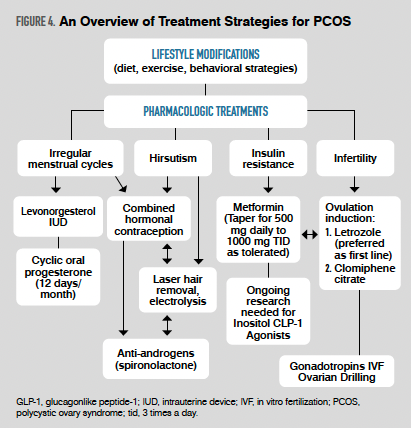
Women with PCOS at risk of developing IR should be counseled on lifestyle modifications but also should be considered candidates for metformin. Metformin is generally started at a low dose (500 mg daily) and gradually tapered up to 1000 mg 3 times daily over several weeks. Inositol is a naturally occurring sugar that has been shown to improve insulin sensitivity, and although there is emerging evidence for its use in women with PCOS and IR, it is still considered experimental.3
Lastly, glucagonlike peptide-1 (GLP-1) agonists have become increasingly popular for promoting weight loss by delaying gastric emptying and inhibiting appetite. A 2019 meta-analysis found that GLP-1 agonists were more effective than metformin in improving insulin sensitivity and reducing abdominal girth and BMI in women with PCOS.45 Although these were exciting findings, the authors of this meta-analysis concluded that the available evidence is of moderate to low quality and that additional higher-quality studies are needed to determine the safety and efficacy of GLP-1 agonists in PCOS management.45 Current guidelines state that antiobesity medications (such as GLP-1 agonists) should be considered experimental for use in PCOS.46
Infertility management for PCOS is focused on ovulation induction. Letrozole and clomiphene citrate are oral medications used in combination with timed intercourse or intrauterine insemination to achieve pregnancy. A landmark study found that women with PCOS who received letrozole had higher cumulative live birth rates than the clomiphene group, without significant differences in multifetal gestations, congenital fetal anomalies, or pregnancy loss.47 In cases when letrozole is unavailable or the patient has a poor response to the medication, clomiphene citrate can be used for ovulation induction.46 If additional factors contribute to the couple’s infertility, it may be appropriate to refer them to a reproductive endocrinologist for potential use of gonadotropins and/or in vitro fertilization.
Conclusions
PCOS is a common endocrine disorder affecting reproductive-aged women. An understanding of the diagnostic criteria is important to differentiate this condition from other similarly presenting diagnoses. Several consequences are associated with PCOS, including infertility, insulin resistance, dyslipidemia, metabolic syndrome, OSA, and mood disorders, that should be considered and appropriately screened for. Management of PCOS includes a combination of lifestyle modifications and pharmacologic treatments targeted toward specific symptoms. Combined hormonal contraceptives are the first-line treatment for hirsutism and irregular menstrual cycles, and letrozole is the first-line treatment for anovulatory/oligo-ovulatory infertility associated with PCOS.
Jessica L. Chan, MD, MSCE, is an associate professor of obstetrics and gynecology specializing in reproductive endocrinology at Cedars-Sinai Medical Center in Los Angeles, California.
Katherine Moran, MD, MBA, is a physician in the Department of Obstetrics and Gynecology at Cedars-Sinai Medical Center.
Katherine Vanhise, MD, is a physician in the Department of Obstetrics and Gynecology at Cedars-Sinai Medical Center.
References:
1. Escobar-Morreale HF. Polycystic ovary syndrome: definition, aetiology, diagnosis, and treatment. Nat Rev Endocrinol. 2018;14(5):270-284. doi:10.1038/nrendo.2018.24
2. Hatch R, Rosenfield RL, Kim MH, Tredway D. Hirsutism: implications, etiology, and management. Am J Obstet Gynecol. 1981;140(7):815-830. doi:10.1016/0002-9378(81)90746-8
3. Teede HJ, Misso ML, Costello MF, et al; International PCOS Network. Recommendations from the international evidence-based guideline for the assessment and management of polycystic ovary syndrome. Fertil Steril. 2018;110(3):364-379. doi:10.1016/j.fertnstert.2018.05.004
4. American College of Obstetricians and Gynecologists' Committee on Practice Bulletins—Gynecology. ACOG Practice Bulletin No. 194: Polycystic ovary syndrome Obstet Gynecol. 2018;131(6):e157-e171. doi:10.1097/AOG.0000000000002656
5. Azziz R. Polycystic ovary syndrome. Obstet Gynecol. 2018;132(2):321-336. doi:10.1097/AOG.0000000000002698
6. Rotterdam ESHRE/ASRM-Sponsored PCOS consensus workshop group. Revised 2003 consensus on diagnostic criteria and long-term health risks related to polycystic ovary syndrome (PCOS). Hum Reprod. 2004;19(1):41-47. doi:10.1093/humrep/deh098
7. Lujan ME, Chizen DR, Pierson RA. Diagnostic criteria for polycystic ovary syndrome: pitfalls and controversies. J Obstet Gynaecol Can. 2008;30(8):671-679. doi:10.1016/S1701-2163(16)32915-2
8. Azziz R, Carmina E, Dewailly D, et al; Androgen Excess Society. Positions statement: criteria for defining polycystic ovary syndrome as a predominantly hyperandrogenic syndrome: an Androgen Excess Society guideline. J Clin Endocrinol Metab. 2006;91(11):4237-4245. doi:10.1210/jc.2006-0178
9. Fauser BC, Tarlatzis BC, Rebar RW, et al. Consensus on women's health aspects of polycystic ovary syndrome (PCOS): the Amsterdam ESHRE/ASRM-sponsored 3rd PCOS Consensus Workshop Group. Fertil Steril. 2012;97(1):28-38.e25. doi:10.1016/j.fertnstert.2011.09.024
10. Lizneva D, Suturina L, Walker W, Brakta S, Gavrilova-Jordan L, Azziz R. Criteria, prevalence, and phenotypes of polycystic ovary syndrome. Fertil Steril. 2016;106(1):6-15. doi:10.1016/j.fertnstert.2016.05.003
11. Speiser PW. Congenital adrenal hyperplasia owing to 21-hydroxylase deficiency. Endocrinol Metab Clin North Am. 2001;30(1):31, vi. doi:10.1016/s0889-8529(08)70018-5
12. Laufer MR, Floor AE, Parsons KE, Kuntz KM, Barbieri RL. Hormone testing in women with adult-onset amenorrhea. Gynecol Obstet Invest. 1995;40(3):200-203. doi:10.1159/000292335
13. Cavlan D, Bharwani N, Grossman A. Androgen- and estrogen-secreting adrenal cancers. Semin Oncol. 2010;37(6):638-648. doi:10.1053/j.seminoncol.2010.10.016
14. Vink JM, Sadrzadeh S, Lambalk CB, Boomsma DI. Heritability of polycystic ovary syndrome in a Dutch twin-family study. J Clin Endocrinol Metab. 2006;91(6):2100-2104. doi:10.1210/jc.2005-1494
15. Hiam D, Moreno-Asso A, Teede HJ, et al. The genetics of polycystic ovary syndrome: an overview of candidate gene systematic reviews and genome-wide association studies. J Clin Med. 2019;8(10):1606. doi:10.3390/jcm8101606
16. Merkin SS, Phy JL, Sites CK, Yang D. Environmental determinants of polycystic ovary syndrome. Fertil Steril. 2016;106(1):16-24. doi:10.1016/j.fertnstert.2016.05.011
17. He C, Lin Z, Robb SW, Ezeamama AE. Serum vitamin D levels and polycystic ovary syndrome: a systematic review and meta-analysis. Nutrients. 2015;7(6):4555-4577. doi:10.3390/nu7064555
18. Merkin SS, Azziz R, Seeman T, et al. Socioeconomic status and polycystic ovary syndrome. J Womens Health (Larchmt). 2011;20(3):413-419. doi:10.1089/jwh.2010.2303
19. Palioura E, Kandaraki E, Diamanti-Kandarakis E. Endocrine disruptors and polycystic ovary syndrome: a focus on bisphenol A and its potential pathophysiological aspects. Horm Mol Biol Clin Investig. 2014;17(3):137-144. doi:10.1515/hmbci-2014-0003
20. Kandaraki E, Chatzigeorgiou A, Livadas S, et al. Endocrine disruptors and polycystic ovary syndrome (PCOS): elevated serum levels of bisphenol A in women with PCOS. J Clin Endocrinol Metab. 2011;96(3):E480-E484. doi:10.1210/jc.2010-1658
21. Glintborg D, Mumm H, Hougaard D, Ravn P, Andersen M. Ethnic differences in Rotterdam criteria and metabolic risk factors in a multiethnic group of women with PCOS studied in Denmark. Clin Endocrinol (Oxf). 2010;73(6):732-738. doi:10.1111/j.1365-2265.2010.03873.x
22. Guo M, Chen ZJ, Eijkemans MJ, Goverde AJ, Fauser BC, Macklon NS. Comparison of the phenotype of Chinese versus Dutch Caucasian women presenting with polycystic ovary syndrome and oligo/amenorrhoea. Hum Reprod. 2012;27(5):1481-1488. doi:10.1093/humrep/des018
23. Zhao Y, Qiao J. Ethnic differences in the phenotypic expression of polycystic ovary syndrome. Steroids. 2013;78(8):755-760. doi:10.1016/j.steroids.2013.04.006
24. Huang Z, Yong EL. Ethnic differences: is there an Asian phenotype for polycystic ovarian syndrome? Best Pract Res Clin Obstet Gynaecol. 2016;37:46-55. doi:10.1016/j.bpobgyn.2016.04.001
25.Chan JL, Kar S, Vanky E, et al. Racial and ethnic differences in the prevalence of metabolic syndrome and its components of metabolic syndrome in women with polycystic ovary syndrome: a regional cross-sectional study. Am J Obstet Gynecol. 2017;217(2):189.e1-189.e8. doi:10.1016/j.ajog.2017.04.007
26. Azziz R, Carmina E, Sawaya ME. Idiopathic hirsutism. Endocr Rev. 2000;21(4):347-362. doi:10.1210/edrv.21.4.0401
27. Goodarzi MO, Shah NA, Antoine HJ, Pall M, Guo X, Azziz R. Variants in the 5alpha-reductase type 1 and type 2 genes are associated with polycystic ovary syndrome and the severity of hirsutism in affected women. J Clin Endocrinol Metab. 2006;91(10):4085-4091. doi:10.1210/jc.2006-0227
28. Kakoly NS, Khomami MB, Joham AE, et al. Ethnicity, obesity and the prevalence of impaired glucose tolerance and type 2 diabetes in PCOS: a systematic review and meta-regression. Hum Reprod Update. 2018;24(4):455-467. doi:10.1093/humupd/dmy007
29. Gourgari E, Spanakis E, Dobs AS. Pathophysiology, risk factors, and screening methods for prediabetes in women with polycystic ovary syndrome. Int J Womens Health. 2016;8:381-387. doi:10.2147/IJWH.S104825
30. Ehrmann DA. Metabolic dysfunction in pcos: relationship to obstructive sleep apnea. Steroids. 2012;77(4):290-294. doi:10.1016/j.steroids.2011.12.001
31. Kim JJ, Choi YM. Dyslipidemia in women with polycystic ovary syndrome. Obstet Gynecol Sci. 2013;56(3):137-142. doi:10.5468/ogs.2013.56.3.137
32.Legro RS, Kunselman AR, Dunaif A. Prevalence and predictors of dyslipidemia in women with polycystic ovary syndrome. Am J Med. 2001;111(8):607-613. doi:10.1016/s0002-9343(01)00948-2
33. Talbott E, Clerici A, Berga SL, et al. Adverse lipid and coronary heart disease risk profiles in young women with polycystic ovary syndrome: results of a case-control study. J Clin Epidemiol. 1998;51(5):415-422. doi:10.1016/s0895-4356(98)00010-9
34. Ehrmann DA, Liljenquist DR, Kasza K, Azziz R, Legro RS, Ghazzi MN; PCOS/Troglitazone Study Group. Prevalence and predictors of the metabolic syndrome in women with polycystic ovary syndrome. J Clin Endocrinol Metab. 2006;91(1):48-53. doi:10.1210/jc.2005-1329
35. Talbott E, Guzick D, Clerici A, et al. Coronary heart disease risk factors in women with polycystic ovary syndrome. Arterioscler Thromb Vasc Biol. 1995;15(7):821-826. doi:10.1161/01.atv.15.7.821
36. Legro RS, Gnatuk CL, Kunselman AR, Dunaif A. Changes in glucose tolerance over time in women with polycystic ovary syndrome: a controlled study. J Clin Endocrinol Metab. 2005;90(6):3236-3242. doi:10.1210/jc.2004-1843
37. Talbott EO, Zborowski JV, Rager JR, Boudreaux MY, Edmundowicz DA, Guzick DS. Evidence for an association between metabolic cardiovascular syndrome and coronary and aortic calcification among women with polycystic ovary syndrome. J Clin Endocrinol Metab. 2004;89(11):5454-5461. doi:10.1210/jc.2003-032237
38. Talbott EO, Guzick DS, Sutton-Tyrrell K, et al. Evidence for association between polycystic ovary syndrome and premature carotid atherosclerosis in middle-aged women. Arterioscler Thromb Vasc Biol. 2000;20(11):2414-2421. doi:10.1161/01.atv.20.11.2414
39. Gomez JMD, VanHise K, Stachenfeld N, Chan JL, Merz NB, Shufelt C. Subclinical cardiovascular disease and polycystic ovary syndrome. Fertil Steril. 2022;117(5):912-923. doi:10.1016/j.fertnstert.2022.02.028
40. Dumesic DA, Lobo RA. Cancer risk and PCOS. Steroids. 2013;78(8):782-785. doi:10.1016/j.steroids.2013.04.004
41. Barry JA, Azizia MM, Hardiman PJ. Risk of endometrial, ovarian and breast cancer in women with polycystic ovary syndrome: a systematic review and meta-analysis. Hum Reprod Update. 2014;20(5):748-758. doi:10.1093/humupd/dmu012
42. Yin W, Falconer H, Yin L, Xu L, Ye W. Association between polycystic ovary syndrome and cancer risk. JAMA Oncol. 2019;5(1):106-107. doi:10.1001/jamaoncol.2018.5188
43. Shafiee MN, Khan G, Ariffin R, et al. Preventing endometrial cancer risk in polycystic ovarian syndrome (PCOS) women: could metformin help? Gynecol Oncol. 2014;132(1):248-253. doi:10.1016/j.ygyno.2013.10.028
44. Sadeeqa S, Mustafa T, Latif S. Polycystic ovarian syndrome-related depression in adolescent girls: a review. J Pharm Bioallied Sci. 2018;10(2):55-59. doi:10.4103/JPBS.JPBS_1_18
45. Han Y, Li Y, He B. GLP-1 receptor agonists versus metformin in PCOS: a systematic review and meta-analysis. Reprod Biomed Online. 2019;39(2):332-342. doi:10.1016/j.rbmo.2019.04.017
46. Teede HJ, Misso ML, Costello MF, et al; International PCOS Network. Recommendations from the international evidence-based guideline for the assessment and management of polycystic ovary syndrome. Fertil Steril. 2018;110(3):364-379. doi:10.1016/j.fertnstert.2018.05.004
47. Legro RS, Brzyski RG, Diamond MP, et al; NICHD Reproductive Medicine Network. Letrozole versus clomiphene for infertility in the polycystic ovary syndrome. N Engl J Med. 2014;371(2):119-129. doi:10.1056/NEJMoa1313517
